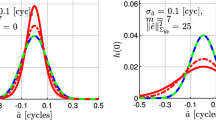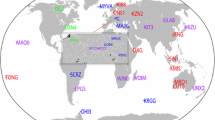Abstract
A key prerequisite for fast and reliable solution convergence time in precise point positioning with ambiguity resolution is the successful determination of the initial integer ambiguity parameters. In this contribution, a reliable approach of partial ambiguity resolution based on the BIE using the t-distribution (BIE-td) is proposed and compared against existing algorithms, such as the partial ambiguity resolution-based LAMBDA method (PAR-Ps) and the iFlex method proposed by the Trimble Navigation company. A 31-day set of GNSS measurements, collected in 2018 from 17 globally distributed GNSS continuously operating reference stations (CORS), were processed to determine the best-fit distribution for the GNSS measurements. It is found that the t-distribution with three degrees of freedoms provides a better fit compared to the Gaussian distribution. The authors then propose a method for selecting the integer ambiguity candidates when using the BIE-td approach. This method is based on the differences of unknown parameters of interest (i.e. receiver’s coordinates) determined at two consecutive processing steps. Finally, another 30-day set of GNSS measurements, collected in 2019 from the same CORS, confirm that the iFlex method outperforms the PAR-Ps method in the sense of minimizing the position errors of a simulated kinematic test. In particular, compared to the PAR-Ps method for 99th percentile of errors, the iFlex method has an improved convergence time of about 10 min. In addition, the positioning performance using the BIE-td and iFlex methods is comparable, with a similar positioning accuracy for both horizontal and vertical coordinate components.





Similar content being viewed by others
Data availability
RINEX observation data from IGS stations and the precise satellite orbits and satellite clocks are real-time streamed using a modified version of the RTKLIB software, with a username and password obtained by Geoscience Australia. The satellite’s phase- and code-biases were obtained from the online archive of the Centre National d’Etudes Spatiales (CNES), http://www.ppp-wizard.net/products/. The open source software RTKLIB for GNSS measurement processing is available at http://www.rtklib.com/.
References
Banville S (2016) GLONASS ionosphere-free ambiguity resolution for precise point positioning. J Geodesy 90(5):487–496
Bertiger W, Desai SD, Haines B, Harvey N, Moore AW, Owen S, Weiss JP (2010) Single receiver phase ambiguity resolution with GPS data. J Geodesy 84(5):327–337
Böhm J, Niell A, Tregoning P, Schuh H (2006) Global Mapping Function (GMF): A new empirical mapping function based on numerical weather model data. Geophys Res Lett 33(7):L07304
Cao W, O’Keefe K, Cannon M (2007) Partial ambiguity fixing within multiple frequencies and systems. In: Proceedings of the 20th international technical meeting of the Satellite Division of the Institute of Navigation (ION GNSS 2007), Fort Worth, TX, USA, 25–28 September, 312–323
Collins P (2008) Isolating and estimating undifferenced GPS integer ambiguities. In: Proceedings of the 2008 national technical meeting of the Institute of Navigation, San Diego, CA, USA, 28–30 January, 720–732
Collins P, Bisnath S (2011) Issues in ambiguity resolution for precise point positioning. In: Proceedings of the ION GNSS 2011, Institute of Navigation, Portland, Oregon, USA, 20–23 September, 679–687
Dach R, Lutz S, Walser P, Fridez P (2015) Bernese GNSS software version 5.2. Astronomical Institute, University of Bern, Switzerland
Dai L, Eslinger D, Sharpe T (2007) Innovative algorithms to improve long range RTK reliability and availability. In: Proceedings of the ION NTM, San Diego, CA, USA, 22–24 January, 860–872
De Jonge P, Tiberius C (1996) The LAMBDA method for integer ambiguity estimation: implementation aspects. LGR-Series, Technical report, Delft University of Technology (12)
Duong V, Harima K, Choy S, Laurichesse D, Rizos C (2019a) Assessing the performance of multi-frequency GPS Galileo and BeiDou PPP ambiguity resolution. J Spatial Sci. https://doi.org/10.1080/14498596.2019.1658652
Duong V, Harima K, Choy S, Laurichesse D, Rizos C (2019b) An assessment of wide-lane ambiguity resolution methods for multi-frequency multi-GNSS precise point positioning. Surv Rev. https://doi.org/10.1080/00396265.2019.1634339
El-Mowafy A, Deo M, Rizos C (2016) On biases in precise point positioning with multi-constellation and multi-frequency GNSS data. Meas Sci Technol 27(3):035102. https://doi.org/10.1088/0957-0233/27/3/035102
Ge M, Gendt G, Rothacher M, Shi C, Liu J (2008) Resolution of GPS carrier-phase ambiguities in Precise Point Positioning (PPP) with daily observations. J Geodesy 82(7):389–399. https://doi.org/10.1007/s00190-007-0187-4
Geng J, Guo J, Chang H, Li X (2018) Toward global instantaneous decimeter-level positioning using tightly coupled multi-constellation and multi-frequency GNSS. J Geodesy. https://doi.org/10.1007/s00190-018-1219-y
Geng JH, Meng XL, Dodson AH, Ge MR, Teferle FN (2010) Rapid re-convergences to ambiguity-fixed solutions in precise point positioning. J Geodesy 84(12):705–714. https://doi.org/10.1007/s00190-010-0404-4
Geng JH, Meng XL, Dodson AH, Teferle FN (2010) Integer ambiguity resolution in precise point positioning: method comparison. J Geodesy 84(9):569–581. https://doi.org/10.1007/s00190-010-0399-x
Guo F, Li X, Zhang X, Wang J (2017) Assessment of precise orbit and clock products for Galileo, BeiDou, and QZSS from IGS Multi-GNSS Experiment (MGEX). GPS Solut 21(1):279–290. https://doi.org/10.1007/s10291-016-0523-3
Laurichesse D (2015) Handling the biases for improved triple-frequency PPP convergence. GPS World
Laurichesse D, Banville S (2018) Instantaneous centimeter-level multi-frequency precise point positioning. GPS World (Innovation Column)
Laurichesse D, Blot A (2016) Fast PPP convergence using multi-constellation and triple-frequency ambiguity resolution. Proc. ION GNSS 2016, Institute of Navigation, Portland, Oregon, USA, 12–16 September, 2082–2088
Laurichesse D, Flavien M, Jean-Paul B, Patrick B, Luca C (2009) Integer ambiguity resolution on undifferenced GPS phase measurements and its application to PPP and satellite precise orbit determination. Navigation 56(2):135–149. https://doi.org/10.1002/j.2161-4296.2009.tb01750.x
Laurichesse D, Mercier F, Berthias JP (2010) Real-time PPP with undifferenced integer ambiguity resolution, experimental results. In: Proceedings of the ION GNSS 2010, Institute of Navigation, Portland, Oregon, USA, September 21–24, 2534–2544.
Leick A, Rapoport L, Tatarnikov D (2015) GPS satellite surveying, 4th edn. Wiley, New York. https://doi.org/10.1002/9781119018612
Li B, Feng Y, Shen Y (2010) Three carrier ambiguity resolution: distance-independent performance demonstrated using semi-generated triple frequency GPS signals. GPS Solut 14(2):177–184
Li P, Zhang X (2015) Precise point positioning with partial ambiguity fixing. Sensors 15(6):13627–13643. https://doi.org/10.3390/s150613627
Luo X (2013) GPS Stochastic Modelling: Signal quality measures and ARMA processes. Signal Quality Measures and ARMA Processes. Springer , Berlin. https://doi.org/10.1007/978-3-642-34836-5
Madrid PFN (2016) Device and method for computing an error bound of a kalman filter based gnss position solution. US Patent 20160109579A1, 21 April.
Nadarajah N, Khodabandeh A, Wang K, Choudhury M, Teunissen PJG (2018) Multi-GNSS PPP-RTK: from large to small-scale networks. Sensors. https://doi.org/10.3390/s18041078
Niell AE (1996) Global mapping functions for the atmosphere delay at radio wavelengths. J Geophys Rese Solid Earth 101(B2):3227–3246. https://doi.org/10.1029/95JB03048
Odijk D, Nadarajah N, Zaminpardaz S, Teunissen PJG (2017) GPS, Galileo, QZSS and IRNSS differential ISBs: estimation and application. GPS Solut 21(2):439–450. https://doi.org/10.1007/s10291-016-0536-y
Pan L, Xiaohong Z, Fei G (2017) Ambiguity resolved precise point positioning with GPS and BeiDou. J Geodesy 91(1):25–40
Parkins A (2011) Increasing GNSS RTK availability with a new single-epoch batch partial ambiguity resolution algorithm. GPS Solut 15(4):391–402
Petit G, Luzum B (2010) IERS conventions. Bureau international des poids et mesures sevres, France
Shi J (2012) Precise point positioning integer ambiguity resolution with decoupled clocks. Department of Geomatics Engineering University of Calgary, Canada, Calgary
Takasu T (2013) RTKLIB ver. 2.4.2 manual, RTKLIB: an open source program package for GNSS positioning. Tokyo University of Marine Science and Technology, Tokyo, Japan
Takasu T, Yasuda A (2010) Kalman-filter-based integer ambiguity resolution strategy for long-baseline RTK with ionosphere and troposphere estimation. In: Proceedings of the ION GNSS, 21–24 September, Portland, Oregon, USA, 161–171.
Talbot NC, Vollath U (2013) GNSS signal processing methods and apparatus with ambiguity convergence indication. US Patent 8368591B2, 5 February
Teunissen P (1995) The least-squares ambiguity decorrelation adjustment: a method for fast GPS integer ambiguity estimation. Continuation of Bulletin géodésique and manuscripta geodaetica 70(1–2):65–82. https://doi.org/10.1007/BF00863419
Teunissen P, Khodabandeh A (2013) BLUE, BLUP and the Kalman filter: some new results. J Geodesy 87(5):461–473
Teunissen PJG (1993) Least-squares estimation of the integer GPS ambiguities. In: International Association of Geodesy General Meeting Beijing, China
Teunissen PJG (1998) On the integer normal distribution of the GPS ambiguities. Artif Satell 33(2):49–64
Teunissen PJG (1999) An optimality property of the integer least-squares estimator. J Geodesy 73(11):587–593
Teunissen PJG (2001a) GNSS ambiguity bootstrapping: theory and application. In: Proceedings of the international symposium on kinematic systems in Geodesy, geomatics and navigation, Banff, Canada, 5–8 June, 246–254
Teunissen PJG (2001b) Integer estimation in the presence of biases. J Geodesy 75(7):399–407. https://doi.org/10.1007/s001900100191
Teunissen PJG (2003) Theory of integer equivariant estimation with application to GNSS. J Geodesy 77(7):402–410. https://doi.org/10.1007/s00190-003-0344-3
Teunissen PJG (2007) Best prediction in linear models with mixed integer/real unknowns: theory and application. J Geodesy 81(12):759–780
Teunissen PJG, Joosten P, Tiberius C (1999) Geometry-free ambiguity success rates in case of partial fixing. In: Proceedings of the ION NTM 1999, San Diego, CA, 25–27 January, 25–27
Teunissen PJG, Khodabandeh A (2014) Review and principles of PPP-RTK methods. J Geodesy 89(3):217–240. https://doi.org/10.1007/s00190-014-0771-3
Teunissen PJG, Montenbruck O (2017) Springer handbook of global navigation satellite systems. Springer , Cham
Teunissen PJG, Verhagen S (2008) GNSS ambiguity resolution: when and how to fix or not to fix? In: Proceedings of the VI Hotine-Marussi Symposium on Theoretical and Computational Geodesy, 29 May, Springer, 143–148
Verhagen S, Li B (2012) LAMBDA software package: Matlab implementation, version 3.0. Mathematical Geodesy and Positioning, Delft University of Technology and Curtin University, Perth, Australia
Verhagen S, Teunissen PJG (2005) Performance comparison of the BIE estimator with the float and fixed GNSS ambiguity estimators. In: Proceedings of the international association of geodesy symposia—a window on the future of geodesy, Sapporo, Japan, 30 June, Springer, Berlin, pp 428–433
Verhagen S, Teunissen PJG (2013) The ratio test for future GNSS ambiguity resolution. GPS Solut 17(4):535–548. https://doi.org/10.1007/s10291-012-0299-z
Verhagen S, Teunissen PJG, van der Marel H, Li B (2011) GNSS ambiguity resolution: which subset to fix. In: Proceedings of the IGNSS symposium, Sydney, Australia, 15–17 November, 15–17.
Verhagen S, Tiberius C, Li B, Teunissen PJG (2012) Challenges in ambiguity resolution: Biases, weak models, and dimensional curse. In: Proceedings of the Satellite Navigation Technologies and European Workshop on GNSS Signals and Signal Processing, (NAVITEC), 2012 6th ESA Workshop on, Noordwijk, Netherlands, 5–7 December, 1–8. https://doi.org/10.1109/NAVITEC.2012.6423075
Vollath U (2014) GNSS signal processing methods and apparatus with scaling of quality measure. US Patent 8704708B2, 22 April
Vollath U, Talbot NC (2013) GNSS signal processing methods and apparatus with candidate set selection. US Patent 008368590B2, 5 February
Wang J, Feng Y (2013) Reliability of partial ambiguity fixing with multiple GNSS constellations. J Geodesy 87(1):1–14. https://doi.org/10.1007/s00190-012-0573-4
Zhou F, Dong D, Li P, Li X, Schuh H (2019) Influence of stochastic modeling for inter-system biases on multi-GNSS undifferenced and uncombined precise point positioning. GPS Solut 23(3):59
Acknowledgements
Geoscience Australia and the IGS are acknowledged for providing the GNSS data as well as satellite orbit and clock corrections. The Raijin-NCI National Computational Infrastructure Australia is acknowledged for providing high-performance research computing resources for GNSS data processing. The authors thank Dr. Simon Banville for valuable discussions and encouragement in relation to this research. The contribution of Dr. Safoora Zaminpardaz for improving the theoretical part and reviewing the manuscript is greatly appreciated. The first author is supported by the Australia Award Scholarship Scheme to pursue a Ph.D. at the RMIT University, Melbourne, Australia.
Author information
Authors and Affiliations
Contributions
V. Duong designed the research, processed and analysed data and wrote the paper. K. Harima, S. Choy and C. Rizos advised the first author, and reviewed and improved the manuscript.
Corresponding author
Rights and permissions
About this article
Cite this article
Duong, V., Harima, K., Choy, S. et al. GNSS best integer equivariant estimation using multivariant t-distribution: a case study for precise point positioning. J Geod 95, 10 (2021). https://doi.org/10.1007/s00190-020-01461-w
Received:
Accepted:
Published:
DOI: https://doi.org/10.1007/s00190-020-01461-w




